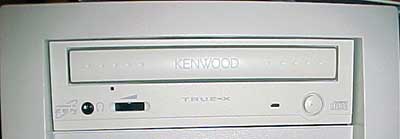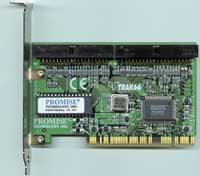SYS Technologies Cold Fusion 1000 - Athlon 1GHz
by Anand Lal Shimpi on January 4, 2000 1:50 AM EST- Posted in
- Systems
SYS offers a number of storage options with the Cold Fusion 1000 that are very performance oriented as well as cost effective. We were given a look at the “base” storage configuration which consisted of two 9.1GB IBM 7200 RPM Ultra ATA 66 drives connected to a Promise FastTrack66 IDE RAID controller. The FastTrack66 is an update over the original FastTrack from Promise which, as the name implies, adds Ultra ATA 66 support to the card.
The drives are configured from the factory in RAID 0 mode which allows the two drives to act as one large 18GB drive yet achieve a theoretical maximum level of performance equal to that of their combined transfer rates. The idea of IDE RAID has been around for a little while now as an alternative to the more expensive SCSI RAID setups and it allows for some very high performance storage configurations without an incredible cost.
The performance improvement provided by the RAID 0 configuration of the two IBM drives was definitely noticeable in disk intensive operations, but, if your usage patterns are not characterized by disk intensive operations that benefit from higher transfer rates, you would be better off going with a single drive. Since the AMD 756 South Bridge on the Gigabyte GA-7IX motherboard supports Ultra ATA 66 natively, you would not only save on the cost of the second drive but on the cost of the FastTrack66 controller as well.

Our evaluation unit came equipped with a Kenwood 72X True-X CDROM drive. Taken from our review of Kenwood’s 52X True-X drive, here is a brief explanation of the need for the technology and the technology itself which was developed by Zen Research:
Starting with 4X drives, CD-ROM speeds were constantly being ramped up. Initially, increases in speed were gained by simply spinning the disc faster, which was successful for speeds up to about 12X.
Then someone got smart and realized that CD's were read using a constant linear velocity method (CLV), which means that the disc was spinning slower while reading the outer edges. This realization brought a new method, constant angular velocity (CAV), to read CD's. This meant that the disc was always spinning at the same rotational rate, regardless of what portion of the disc was being read.
That leads to data that is actually passing by the reading head faster on the outer portions of the disc, and thus higher transfer rates on the outer part of the disc. A by product of using CAV technology is that the drive motor does not need to change speeds, so access times are improved.
By simply implementing CAV, those 12X drives immediately became 24X "max" drives where the inner part of the disc was actually read at 12X and the outer part at 24X. Further increases in rotational speed have led to today's 50X "max" drives.
Unfortunately, data is written to a CD starting at the inside and discs are rarely filled to capacity. Thus, the max speed rating was not particularly meaningful. Further, the rotational speed required for a 50X drive is over 10,000 RPM, leading to major noise issues - some of those drives sound like jet engines while they are spinning!











2 Comments
View All Comments
Anjuchauhan - Saturday, October 6, 2018 - link
This is not a big problem of the asiomi.sys file, you can protect your system with downloading the https://unfitpc.com/asiomi-sys it can be resolve your hurdle.Riyasharma123 - Thursday, July 15, 2021 - link
Another design proposed to use the neutrons to breed fission fuel in a https://techzoan.com/how-to-take-a-screenshot-on-w... blanket of nuclear waste, a concept known as a fission-fusion hybrid